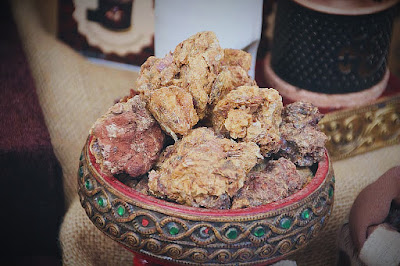American hoodoo magic, with its blend of African, Indigenous, and European traditions, has a long history of utilizing various herbs, roots, and materials to create potent spells and rituals. One such ingredient that holds a significant place is myrrh. It is not a native plant to the Americas: commiphora myrrha is native to the Arabian penninsula and Africa. It appears often in the Bible, and because of this was adopted into European high magical traditions. As I mention in my book Conjuration, incense wasn't much used in American hoodoo till the early 20th century, when the "catalogue culture" of De Laurence and others brought to it more high magical tradition and incorporated imported ingredients into the practice. As said above, the essential oil of myrrh is very expensive, and since hoodoo is a common person's folk magic, it's been typical to use the more affordable artificial versions of its fragrance in traditional hoodoo items from the 20th century onward.
Evidently it is so popular a fragrance that almost everything winds up smelling like it, because the ingredient gets worked into just about everything at some point or another.
In the realm of modern hoodoo magic, myrrh takes on the role of a multitasking magician's assistant. It is often used as an incense to cleanse and purify spaces, allowing practitioners to create a conducive environment for their rituals. The rich and smoky scent of burning myrrh is believed to open channels to the spirit realm, inviting benevolent energies to participate in the practitioner's intentions. Just as it was presented as a gift to the divine in ancient rituals, myrrh is used as an offering to spirit guides and deities, bridging the gap between the tangible and the divine.
It has something of a "neutral" property in hoodoo that allows it to be employed in both positive and negative works. In positive spells it's often mixed with frankincense, though this ingredient too is magically neutral. In the realm of magical correspondences, myrrh has long been associated with the Moon, Saturn, and the element of Water. This multiplicity of associations highlights its versatility in spellwork. The resin is renowned for its capacity to facilitate spiritual healing, protection, and purification. In hoodoo, myrrh has emerged as a cornerstone ingredient for rituals that span from banishing negativity to calling forth benevolent spirits.
LOVE MAGIC AND RECONCILIATION: Myrrh is employed in spells to mend broken bonds and rekindle passion. Its soothing and healing properties are believed to mend emotional wounds and promote forgiveness. It is used in Cleopatra formulas, and in some Intranquility formulas. An ancient Greek love spell consisted of nothing more than praying over burning myrrh and commanding its fumes to soften the heart of the targeted person, with a prayer very similar to the intranquility prayers. To mend a broken heart, create a mixture of powdered myrrh resin, rose petals, and a pinch of sea salt. Light a pink candle, rub it with Healing oil, and dress it with this herb mixture before burning.
MASTERY AND POWER: Myrrh also is used for strength, power and wisdom. An old hoodoo catalogue promises that mixing vetivert oil and myrrh together and burning this incense is good for "personal magnetism and power."
PROTECTION AND CLEANSING: Myrrh's protective qualities are also harnessed in hoodoo magic. For purification, it can be mixed with copal and/or frankincense and burned to dispel harm and negative influences. For protection, a gris-gris of myrrh, frankincense, rue and salt can be carried on the person.
MONEY SPELLS: Myrrh's historical use as a valuable trade commodity adds to its reputation as a symbol of abundance and prosperity. You can make a lucky money mojo bag by taking a green or gold pouch and filling it with cinnamon, pyrite, and $2 bill on which you have signed your name in gold ink. Baptize the bag by dressing it with myrrh oil or reanoint it every week or smoke it in myrrh incense every week for as long as you need the bag to work.
JINXES AND HEXES: When working any jinx or hex, myrrh incense is a spiritually safe mixture to burn in your own home to enhance the work without subjecting yourself to the usual harmful influences of spicy and baneful herbs that are typical in cursing formulations.
